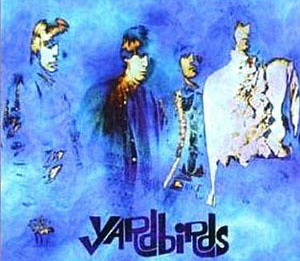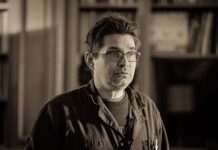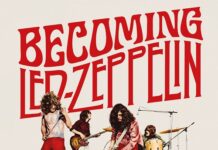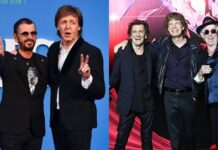Story by Shawn Perry
Photos by Ron Lyon
Unlike other first-string British invaders like the Beatles, the Rolling Stones, the Who and the Kinks, there was little controversy surrounding the Yardbirds (aside from the occasional Jeff Beck flare-up). That may be because the Yardbirds were more about playing the blues — The Most Blueswailing Band! — instead of living them. Face it: the first thing most people think about when they think about the Yardbirds are the three seminal guitar heroes that paid their dues and plied their trade in the band — Eric Clapton, Jeff Beck and Jimmy Page.
But even as they are primarily known as a guitar band — with a heavy emphasis on the “gee-tar” — the Yardbirds also wrote and recorded some incredibly mind-blowing songs, reinforced the frontline with an equally strong backline, and had a singer with a nasally range that fell somewhere between Mick Jagger and Jim Morrison’s, as well as commendable skills on the harp.
Everyone knows what happened to Clapton, Beck and Page after the Yardbirds broke up in 1968 — but the other members didn’t fare so badly either. Singer Keith Relf and drummer Jim McCarty switched gears and formed the folk progressive rock band Renaissance. Although Relf died from a tragic accident in 1976, he had been recording, writing and producing records until the very end. Original bassist Paul Samwell-Smith enjoyed a successful career producing records for Cat Stevens, Carly Simon and many others. Rhythm guitarist and bassist Chris Dreja became a photographer.
Like every good rock and roll band, they were bound to come back.
So, out of a box of frogs, so to speak, the Yardbirds returned in the early 90s with McCarty and Dreja at the helm and a revolving door of new members. These days, Andy Mitchell sings lead vocals and plays harmonica, Ben King is the lead guitar player, and David Smale plays bass. Together with McCarty and Dreja, the five tour the world, celebrating those great songs and bluesy riffs of the Yardbirds.
Speaking with McCarty a few weeks before the band’s Fall 2011 trek to the U.S., the drummer told me the band had been making regular trips to the States for some time. He was, however, looking forward to bringing over the latest lineup.
“We’ve got a pretty young band now, apart from me and Chris,” he said. “It’s a good band with a mixture of young and old.”
Chris Dreja, whom I also talked with prior to the tour, added: “If anything, the band is more energetic now than it was in the 60s.”
True to their word, the new members of the Yardbirds are exceeding expectations and keeping the flame burning. When they rolled through Southern California, I ventured down to the Coach House for their September 22 performance and was completely taken aback.
I’d never seen the Yardbirds in concert, only on video, so it was refreshing to hear songs like “For Your Love,” “Heart Full of Soul,” “Shapes of Things,” “I’m A Man,” “Over Under Sideways Down,” “Train Kept A- Rolling” and my personal favorite, “Happening Ten Years Time Ago,” live.
Mitchell sang each tune with heart and conviction. A splash of Relf-like nuances kept it authentic. And boy could this kid blow some harp. He really came to bat on “Drinking Muddy Water,” a straight ahead, boogie-woogie, bluesy remnant from the Jimmy Page era that stops and starts like a screaming freight train.
King, who’s been with the Yardbirds since 2005 and appears on the double-CD Live At B.B. King Blues Club, confidently assumes the role of lead guitarist of the Yardbirds — maybe the biggest shoes to fill in any rock and roll band. McCarty told me he’s around the same age as Clapton and Beck when they were in the band. At the Coach House, you could see signs of the all the above integrated into a unique and modern style. King could easily be on this way to super-stardom in the coming years.
I asked McCarty and Dreja about the possibility of making new music with this lineup. Both are receptive to the idea, but they are also cautious about the legacy. Dreja was more to the point: “It has to be very Yardbirds,” he said. “You have to make sure the bloodline is right.”
He mentioned that Mitchell is a songwriter and writes his own music. “He is bringing ideas to the band,” the guitarist said. “We’ll have to see how it works out.”
McCarty doesn’t rule out the idea of new Yardbirds music. “It’s always possible. It’s not easy getting new songs because it’s a very strong repertoire. It’s difficult to get a song as good as ‘For Your Love’ or ‘Smokestack Lightning,’” he laughed.
In 2003, the Yardbirds issued Birdland, their first new album in over 35 years. Released on Steve Vai’s Favored Nations label, the album included then-Yardbirds guitarist Gypie Mayo and John Idan on bass and lead vocals, along with appearances from heavy hitters like Vai, Joe Satriani, Slash, Brian May, Steve Lukather, Jeff “Skunk” Baxter, and even former member Jeff Beck on one song.
In addition to playing and writing, Dreja also did the artwork — something he knew a little something about. It was, in fact, Dreja’s goofy doodle that became the cover of the 1966 Yardbirds album of all originals, Roger The Engineer.
“It’s a bit of a tradition really,” he said. “I suppose I’m cheap, but I’m also a bit crazy in the head, so I came up with some weird ideas.”
As someone who could have played bass for Led Zeppelin, but instead shot the photo that adorns the back cover of Zep’s debut album (“the purity of those young men, apart from Jimmy, about to go into the music business, was an amazing photo”) — Dreja has enjoyed a successful career as a commercial photographer and artist since the band first broke up in 1968. Many of his photos of Zeppelin have appeared in books and magazines, and he is in the process of preparing limited edition prints for sale to the public.
“There’s a half-dozen of very unique pictures,” he said. “Of the limited editions, I have some signed by Jimmy (Page), which was very kind of him.”

As one of the Yardbird’s main songwriters, McCarty recently released his second solo album, Sitting On Top Of Time, featuring songs that are, as he puts it, “more lyrical and softer.” I reminded him that much of the record sounds like something he would have written for Renaissance and he agreed.
Steve Hackett, Jean-Michael Kajden, Lou Pamnati and Ron Korb all appear on the album. McCarty and Hackett are old friends (“He played on some of the Box Of Frogs songs in the 80s. And he’s a big fan of Roger The Engineer”), so the drummer wrote “Living For The Inside Out,” with the Genesis guitarist in mind.
Whatever the subject may be, songwriting is a constant in McCarty’s life. “I have songs going through my head all the time,” he said. “Living down here (in France), it’s an easy place to get inspired.”
So I reverted back to the idea of a new Yardbirds album by asking McCarty if he ever writes anything that would work within the context of the Yardbirds. “Well, you never know, they might slip in,” he laughed.
I’ve often wondered how Dreja and McCarty, along with Samwell-Smith and Relf, felt about being sidelined by the spotlight that fell upon Clapton, Beck and Page in the 60s. The drummer and guitarist both offered some keen insights into the phenomenon.
“We got used to that,” McCarty explained. “The fact that we’ve carried on has made people realize there’s some other talent in the band.”
McCarthy acknowledged that the guitarists helped cement the band’s reputation. “They put the Yardbirds on the map,” he said. “It’s a two-way thing.”
Dreja offered a slightly different view. “I’m a background boy, more an observer. I was quite happy to jam behind those guys and make them sound as good as I could.”
And of the three, who was the best?
“I was very close to Eric,” Dreja said. “He taught me about the blues. Jeff is a genius and Jimmy had all that vast studio experience and was very professional.”
“They’re all fantastic, what can you say?” McCarty remarked candidly. “Jeff is the most creative, but he was the most difficult too,” he laughed. “Jimmy was the easiest.”
All in all, McCarty and Dreja are proud of the band and its rich history. Both were honored to be inducted, along with former members Beck, Page, Samwell-Smith (Clapton was on tour) and Relf’s family members, into the Rock and Roll Hall Of Fame in 1992.
“We always tried to do things that people said we shouldn’t be doing, and quite frankly I’m glad we did. And we were recognized for that,” Dreja said. For McCarty, the thrill of the induction was seeing Johnny Cash standing next to Neil Young.
After the U.S. Fall tour wrapped, the drummer told me he was playing some solo shows in Toronto. Dreja said the Yardbirds have future touring plans that will take them to such exotic locales as Czechoslovakia and Tel Aviv. They completed a tour in Japan, just a few days before the earthquake and tsunami devastated the country.
And there is serious talk about a live album with the new lineup.
But for now, as it was at the Coach House, the Yardbirds are happy playing out, revisiting these immortal rock and roll gems. They are grateful for the experiences that fueled their passion for the Yardbirds and its music.
Dreja recalled the band’s rise during the turbulence of the 60s, witnessing riots in Los Angeles and Detroit during their mid 60s tours. “There was such an apartheid in the U.S.,” he said.
Then, as it is now, the group’s commitment to the songs and the sound comprise the heart of their appeal, no matter who, when or where that may be. “We were playing the Fillmore, where everyone was high on LSD,” Dreja mused with a laugh. “But we were just high on the music.”





















